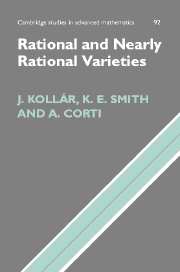6 - Singularities of pairs
Published online by Cambridge University Press: 25 May 2010
Summary
In the last chapter, we introduced the Noether–Fano method for proving nonrationality of certain varieties. In this chapter, we develop further practical techniques for carrying out this program.
To successfully use the Noether–Fano method, one needs to verify whether or not linear systems admit maximal centers. Recall that a maximal center is, roughly speaking, a place where there is a significant discrepancy between the birational transform and the pullback of a linear system. In this chapter, we develop tools for computing these discrepancies explicitly. The main issues we consider are the behavior of discrepancies under changing birational models, under finite morphisms, and under restriction to hypersurfaces.
As our main application, we prove Theorem 5.20 on the numerical consequences at isolated maximal centers on a threefold, which was used in our proof of the nonrationality of smooth quartic threefolds. The classical proof of Theorem 5.20 consisted of rather intricate computations on a suitable resolution of the singularities of the linear system, but we here place the result in the more conceptual framework of singularities of pairs.
The first three sections develop the basic theory of discrepancies and singularities of pairs. Our motivation is that a linear system has a maximal center if and only if the corresponding pair fails to be canonical. The important issues of how discrepancies can be computed from a log resolution and how they behave under finite maps are treated in the exercises.
- Type
- Chapter
- Information
- Rational and Nearly Rational Varieties , pp. 149 - 181Publisher: Cambridge University PressPrint publication year: 2004

